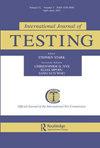The Recovery of Correlation Between Latent Abilities Using Compensatory and Noncompensatory Multidimensional IRT Models
IF 1.4
Q2 SOCIAL SCIENCES, INTERDISCIPLINARY
引用次数: 1
Abstract
This research examined correlation estimates between latent abilities when using the two-dimensional and three-dimensional compensatory and noncompensatory item response theory models. Simulation study results showed that the recovery of the latent correlation was best when the test contained 100% of simple structure items for all models and conditions. When a test measured weakly discriminated dimensions, it became harder to recover the latent correlation. Results also showed that increasing the sample size, test length, or using simpler models (i.e., two-parameter logistic rather than three-parameter logistic, compensatory rather than noncompensatory) could improve the recovery of latent correlation.利用代偿和非代偿多维IRT模型恢复潜在能力之间的相关性
当使用二维和三维补偿和非补偿项目反应理论模型时,本研究检验了潜在能力之间的相关性估计。模拟研究结果表明,在所有模型和条件下,当测试包含100%的简单结构项时,潜在相关性的恢复最好。当测试测量到弱辨别维度时,恢复潜在相关性变得更加困难。结果还表明,增加样本量、测试长度或使用更简单的模型(即两参数逻辑而非三参数逻辑,补偿而非非补偿)可以提高潜在相关性的恢复。
本文章由计算机程序翻译,如有差异,请以英文原文为准。
求助全文
约1分钟内获得全文
求助全文
来源期刊

International Journal of Testing
SOCIAL SCIENCES, INTERDISCIPLINARY-
CiteScore
3.60
自引率
11.80%
发文量
13
 求助内容:
求助内容: 应助结果提醒方式:
应助结果提醒方式:


